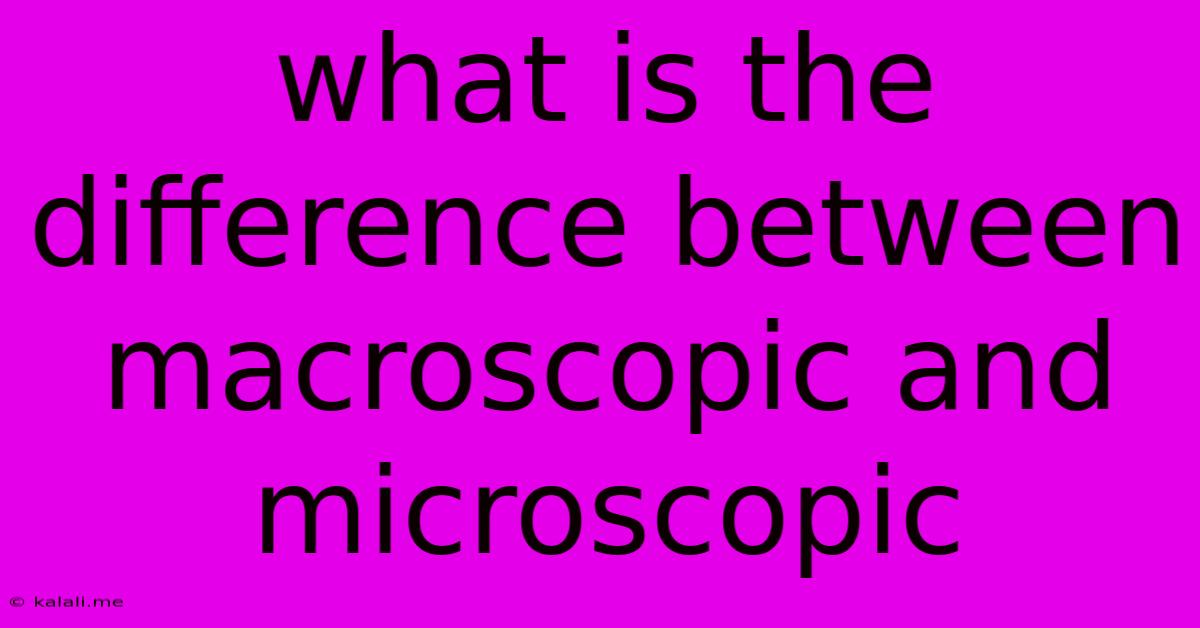What Is The Difference Between Macroscopic And Microscopic
Kalali
Jun 13, 2025 · 3 min read

Table of Contents
Macroscopic vs. Microscopic: Understanding the Scales of Observation
This article delves into the fundamental difference between macroscopic and microscopic, exploring how these perspectives shape our understanding of the world around us. We'll examine the characteristics of each, providing clear examples and explaining the implications of this distinction across various scientific fields.
The key difference lies in the scale of observation: macroscopic refers to objects and phenomena visible to the naked eye, while microscopic refers to those requiring magnification to be seen. This seemingly simple distinction has profound implications for how we study and interpret the universe.
Macroscopic World: The World We See
The macroscopic world encompasses everything we can observe directly without any assistive tools. Think of the vastness of the cosmos, the towering mountains, the intricate patterns of a flower, or even the simple act of walking. These are all examples of macroscopic phenomena. This realm is governed by classical physics, where concepts like gravity, momentum, and energy are readily observable and predictable. We can measure macroscopic properties such as mass, length, and volume using everyday tools.
- Examples of macroscopic properties:
- The height of a tree
- The temperature of a room
- The weight of a car
- The speed of a train
- The color of an object
The study of macroscopic systems often involves dealing with large numbers of particles and their collective behavior. This is the realm of thermodynamics, where we study heat transfer, work, and entropy. Fluid mechanics also falls under the macroscopic umbrella, dealing with the behavior of liquids and gases at a scale visible to the naked eye.
Microscopic World: Unveiling the Invisible
The microscopic world, in contrast, is one of incredible detail and complexity. It's a realm where we observe atoms, molecules, cells, and other structures far too small to be seen without magnification. Microscopes, from simple magnifying glasses to sophisticated electron microscopes, are essential tools for exploring this hidden universe.
This domain is typically governed by the principles of quantum mechanics, which dictates the behavior of matter at the atomic and subatomic levels. Here, the rules of classical physics often break down, and probabilistic descriptions become necessary. For instance, understanding the behavior of electrons within an atom requires the application of quantum mechanics.
- Examples of microscopic properties:
- The structure of a DNA molecule
- The arrangement of atoms in a crystal
- The internal workings of a cell
- The interactions between molecules in a chemical reaction
- The behavior of subatomic particles
The Interplay Between Macroscopic and Microscopic
While seemingly distinct, the macroscopic and microscopic worlds are inextricably linked. The macroscopic properties of a material are ultimately determined by the microscopic interactions of its constituent particles. For example, the hardness of a diamond is a macroscopic property arising from the strong covalent bonds between its carbon atoms—a microscopic characteristic. Similarly, the chemical reactivity of a substance is dictated by the electronic structure of its molecules, a microscopic phenomenon.
Understanding this interplay is crucial for advancements in various fields, including materials science, nanotechnology, medicine, and biology. Bridging the gap between these scales requires sophisticated techniques and theoretical frameworks, enabling scientists to connect microscopic behaviors to macroscopic properties and vice versa. This interdisciplinary approach is essential for solving complex problems and developing innovative solutions.
Conclusion
The distinction between macroscopic and microscopic is fundamental to our understanding of the physical world. While the macroscopic world is the one we directly experience, the microscopic world reveals the underlying mechanisms that govern its behavior. By understanding both perspectives, we gain a deeper appreciation of the intricate complexity and interconnectedness of the universe. Continued exploration of both scales promises further breakthroughs and advancements in countless scientific and technological fields.
Latest Posts
Latest Posts
-
Consider The Following Data For Copper
Jun 14, 2025
-
Formal Charge Of Phosphorus In Po43
Jun 14, 2025
-
University Of Wisconsin La Crosse Acceptance Rate
Jun 14, 2025
-
Which Of The Following Is Pure Substance
Jun 14, 2025
-
Which Of The Following Is Not A Cognitive Process
Jun 14, 2025
Related Post
Thank you for visiting our website which covers about What Is The Difference Between Macroscopic And Microscopic . We hope the information provided has been useful to you. Feel free to contact us if you have any questions or need further assistance. See you next time and don't miss to bookmark.